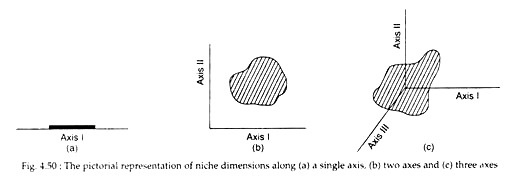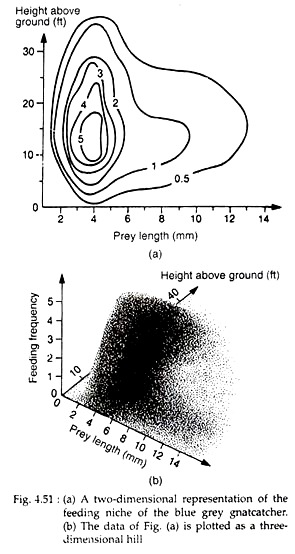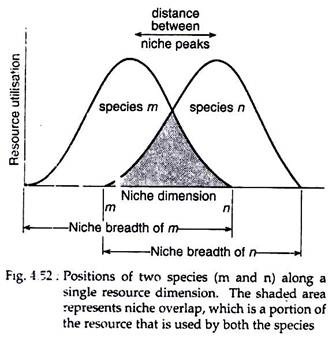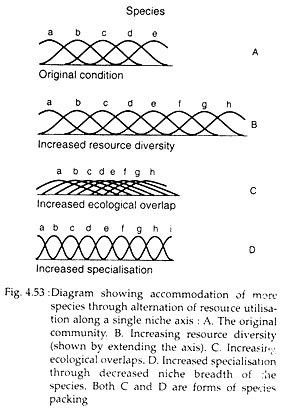In this article we will discuss about:- 1. Aspects of Ecological Niche 2. Concept of Ecological Niche 3. Advantages.
Aspects of Ecological Niche:
The three aspects of ecological niche are designated as:
(i) Spatial or habitat niche,
(ii) Trophic niche, and
ADVERTISEMENTS:
(iii) Multidimensional or hyper volume niche.
(i) Spatial or habitat niche:
Joseph Grinnell’s (1928) thought of a niche in terms of the microhabitat that a species occupies— it is now called spatial niche. Spatial or habitat niche represents the physical space occupied by an organism. Thus, in a habitat occupied by many species, each species is confined to a microhabitat. No two species can occupy the same habitat.
An interesting example of habitat niche was provided by O’Neill (1967). He identified seven species of millipedes living in the forest floor of a maple-oak forest. All the seven species occur in the same basic trophic level as all are detritus feeder.
ADVERTISEMENTS:
The log of maple-oak has several gradients in decomposition stage from the centre to the position underneath the leaf litter. These gradients constitute distinct microhabitats and each specie:; of millipede occupies a specific different microhabitat.
(ii) Trophic niche:
Charles Elton (1927) was the first who used the term niche as the “functional status of an organism in its community”. He thus emphasised the importance of energy relations and, thus, the concept is designated as trophic niche. Trophic niche is concerned with the trophic position of an organism.
Example of trophic niche is provided by weaver birds present in the vicinity of Lake Mweru in Africa. All the three weaver birds present had different choice of food, thus occupying different trophic niches. Two of them, Ploceus collaris and P. melanocephalus, live in the same nest but one feeds on seeds and the other on insects.
ADVERTISEMENTS:
(iii) Multidimensional or hyper-volume niche:
In 1957, G. E. Hutchinson suggested that niche could be visualised as a multidimensional space or hyper-volume. Within this, the environment permits an individual species to survive indefinitely. This niche concept of Hutchinson is designated as multidimensional or hyper-volume niche. In this case the niche can be measured, mathematically manipulated and represented in climo-graphs.
Concept of Ecological Niche:
The ecological niche concept was first formally defined by Hutchinson in 1957. According to him, the activity range of any species could be described along all the dimensions (parameters) of the environment.
These dimensions include physical and chemical parameters such as temperature, humidity, salinity, oxygen concentration etc. and biological factors such as prey species, resting backgrounds against which an individual may escape detection by predators and so on.
Each of these dimensions are represented as dimension in space. Supposing there are ‘n’ number of dimensions, then the niche would be described in n-dimensional space. As it is not possible to visualize a space of more than three dimensions, the multidimensional aspect could only be represented mathematically and statistically, and then depicted by their essence physically or graphically (by set of independent axis).
A graphical representation of a biological activity to a single environmental gradient representing the distribution of a species activity along one niche dimension is given in Fig. 4.50a. It depicts the degree to which the environment can support that species in relation to a particular parameter.
Fig. 4.50b shows two dimensions where the species niche may be depicted as a hill, with contours representing the various levels of biological activity. A three dimensional aspect can be visualised as a cloud in space whose density conveys niche utilisation (Fig. 4.50c).
As an example of the above, the blue-grey gnatcatcher’s (Polioptila caerulea) feeding niche is represented on a two-dimensional graph (4.51a). The length of its prey is represented along the horizontal axis and the height above the ground at which the blue-grey gnatcatcher feed is shown along the vertical axis.
ADVERTISEMENTS:
The contour lines on the figure represents the frequency with which the birds fed at a particular height and on a particular length of the prey. The data of the Fig. 4.51a is represented as a three-dimensional volume in Fig. 4.51b. Here, the feeding niche of the birds is represented as a hill. The peak of the hill shows where the birds are most likely to be found.
As such, other axes such as ambient temperature, risk from predation at different times of the year and so on, could be added to the above figure. It almost becomes impossible to represent graphically the niches where more than two or three environmental variables are involved. However, computers can easily hold and analyse the data.
The total resource space or niche space available to a community is represented as the n-dimensional volume, where the niche of all the species fit or where the niche of each species occupies a part. All the n-dimensions of a species niche is difficult to identify and measure.
However, niche relationship within biological communities can be characterised by observing the patterns of resource utilisation and micro-habitat preferences on one or a few niche dimensions. When the preferences of individuals are plotted on a line representing the resource (or condition), a frequency distribution of utilisation (or tolerance) is obtained for each species (Fig. 4.52).
In this figure the utilisation of resource by individuals of two species m and n are plotted. Some individuals of both the species m and n utilise much more of the resource or some that utilise less. The distribution of each species is characterised by the location of its peak, its breadth and its light.
The extent of the variety of resources used (or the extent of conditions tolerated) by the individuals in the population is represented by the width in the figure and is referred to as the niche breadth. Sometimes the term niche width, used in place of niche breadth, is used to represent the standard deviation of the distribution of the resource used.
Some individuals of species m, showing a higher utilisation of the resource than the average for their population, overlaps in their utilisation of resource with some individuals of species n having lower than average utilisation (represented in the Fig. 4.52 by the shaded region). Such overlap (or similarity) of utilisation of resources (or tolerance of conditions) is called niche overlap.
Such niche overlaps indicate the intensity of competition between species in the community for a particular resource. If the two peaks (Fig. 4.52) of the distribution of species m and n are moved closer together, the niche overlap will increase.
When the curves of m and n totally overlap or when m = n, the utilisation of the resources by the two species (m and n) is said to be identical. When such a situation does occur, one would expect that competitive exclusion would eliminate one of the species from the system.
If the two species—in spite of the similarity in their use of resource—still coexist, then it is called limiting similarity. Sometimes species may be too similar to coexist on one axis, they then differ in their resource utilisation. Such a situation is referred to as niche complementarity.
Species which occupy similar niches in different geographical regions are called ecological equivalent species. They tend to be closely related taxonomically in contiguous regions but often differ in noncontiguous regions. In different floral and faunal regions, the species composition of communities differs widely.
Whenever physical conditions are similar (regardless of geographical locations), similar ecosystems develop equivalent functional niches. A grassland ecosystem thus develops whenever there is a grassland climate, but the species of grass and grazers may be quite different. For example, the kangaroos of the Australian grassland are the ecological equivalents of the bison and pronghorn of the North American grassland.
Fundamental and realised niches:
In 1958, Hutchinson introduced the terms fundamental niche and realised niche. Fundamental niche is the niche that an organism would occupy in the absence of competitors and predators. When the fundamental niches of two species overlap (Fig. 4.52), then the two species are said to be competing with one another.
However, in nature, two species do not overlap or compete for food, even if they eat the items of the same size, as they can look for them in different places. Most well-integrated communities like coral reef, climax forest etc. are made up of species with non-overlapping niches.
Realised niche is referred to as the role an organism actually plays in the community. Hutchinson viewed that the outcome of inter-specific competition would lead either to extinction or the development of differences allowing coexistence. In nature, the realised niche of an organism is smaller than its fundamental niche.
Niche and species diversity:
In the species concept discussed above, the discussion included two species only. If the concept is expanded by taking more than two species (which occurs in a natural community), then some fundamental ideas about the mechanisms regulating diversity in the community can be uncovered.
Addition of species increases the species richness and the community accommodates them in three possible ways:
1. The original species and the added ones could maintain the same niche widths and overlaps and in such case the total niche space has to be increased. Fig. 4.53B depicts the increase by extending the niche axis line which implies the addition of new resource types. This could increase the biodiversity through increased resource diversity.
2. Without increasing the resource diversity the added species could be accommodated by increasing the niche overlaps (Fig. 4.53C). This would lead to a decrease of the average productivity of each species, due to increased sharing of resources.
3. Without increasing niche overlap the added species could be accommodated by increasing species specialisation within a community’s niche space (Fig. 4.53D). Here also the average productivity would decrease as each species would have access to a narrower range of resource. Increase in species richness without a change in resource diversity is called species packing.
Species adaptation and diversity:
Discussion of ecological niche are not limited to resources and physical conditions only. Predation avoidance is also important to population processes. Niche discussion do constitute areas of predator escape along which species may escape from getting noticed. Such niche space that is defined by adaptations (including behaviour) of prey organisms and help them to avoid predation is called escape space.
When many prey species using the same mechanism to escape predation and occupying portions of densely populated niche space, they become very much susceptible to predators having appropriate learning behaviour.
This would result in increased mortality. However, those organisms having unusual adaptation for predator escape would be strongly selected. Thus, predation pressure would diversify prey and make them uniformly distributed within available escape space.
Advantages of Ecological Niche:
1. Animals can escape competition by occupying different ecological niches.
2. The ecological niche occupied by a species is favourable to it as it furnishes a suitable substratum and microclimate.
3. Segregation of organisms into niches avoids confusion of activities in the community and gives a more orderly and efficient life pattern for each species.
4. Segregation of different species in a particular niche results in full exploitation of all available resources.



